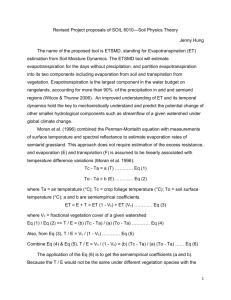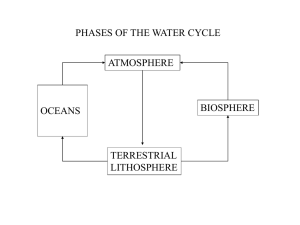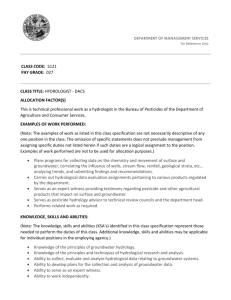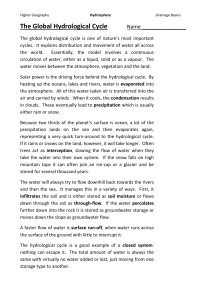Online resource 1 belonging to: Synthesis of ecosystem vulnerability
advertisement
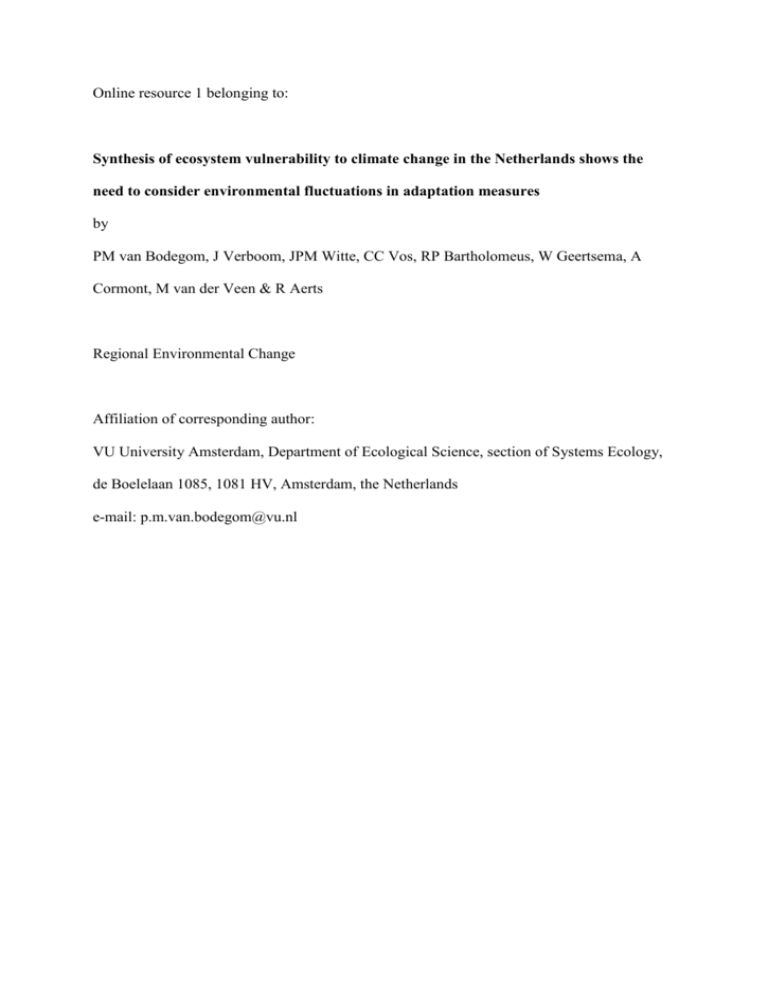
Online resource 1 belonging to: Synthesis of ecosystem vulnerability to climate change in the Netherlands shows the need to consider environmental fluctuations in adaptation measures by PM van Bodegom, J Verboom, JPM Witte, CC Vos, RP Bartholomeus, W Geertsema, A Cormont, M van der Veen & R Aerts Regional Environmental Change Affiliation of corresponding author: VU University Amsterdam, Department of Ecological Science, section of Systems Ecology, de Boelelaan 1085, 1081 HV, Amsterdam, the Netherlands e-mail: p.m.van.bodegom@vu.nl Additional methodological details for impact study 1: Meta-analysis of retreating and expanding species A long tradition of vegetation records in the Netherlands allowed compiling decadal-long records on the occurrence of plant species per 1 km2 grid cells. From this database, we selected three periods, i.e. 1902-1949, 1975-1984 en 1985-1999, to determine local increases and decreases of plant species indicative for ecosystem types prevailing in the Netherlands. Note that most observations were from the latter two periods. Local changes in species occurrence may be due to stochastic events, climate-related changes and land use related impacts. To discriminate among effects by climate vs. other drivers, regression analysis was used to determine for which species changes in local abundance were correlated to climate variables (Tamis et al. 2005). Selected variables indicative of climate include the plot mean Ellenberg indicator value of continentality, and the average temperature of the grid cell in which the respective plant species occurs. Similarly, to evaluate the potential impacts of other environmental changes, plot mean Ellenberg indicator values for nutrient availability, moisture availability, salinity, and acidity were applied. In addition, the impact of 'Urbanity' (as an ordinal factor) was analysed. Here we present the percentage of species for which the local decrease or increase in occurrence was related to climate variables. No relationship between the vulnerability and rareness of ecosystem types was found. Although this analysis does not allow deciphering causality or individual drivers of species distribution, it is indicative for the impacts of climate change. Additional methodological details for impact study 2: Climate impacts sketch map A national hydrology model (Vermulst and de Lange 1999) was run to identify general trends in possible hydrological effects of climate change. The model had a spatial resolution of 250 m and a temporal resolution of 10 days. With the aid of a digital elevation model, simulated groundwater levels and seepage intensities were downscaled to a spatial resolution of 25x25 m. To evaluate hydrological quantities for current climate conditions, we considered two meteorological years (with accurate data quality) to represent climate variability in the current climate: an average (1967) and a dry year (1949), with return periods of 2.5 and 11.7 yr, respectively. This selection was done to obtain feasible computation times. To initiate the appropriate hydrological conditions, the calculation for these two characteristic years was preceded by an additional year of simulations (1966, 1948). For the future climate, we considered two scenarios; W and W+, according to the national climate scenarios (Bakker and Bessembinder 2007). The W scenario assumes an increase in temperature of 2 °C in 2050 without changes in air circulation. The W+ scenario additionally assumes changes in air circulation, leading to wetter winters and drier summers. These national climate scenarios are based on global climate projections based on international consensus of expected change (Solomon et al. 2007), translated to detailed changes in temperature, precipitation and evapotranspiration for the Netherlands. Temperature modulates transpiration, and thus affects the water balance. Impacts of enhanced CO2 levels on transpiration were not incorporated in the simulations. Projected climatic conditions were obtained by transforming time series for temperature, precipitation and evapotranspiration of 1948, 1949, 1966 and 1967 to the 2050-climate of W and W+, using transformation software supplied for these scenarios (Bakker and Bessembinder 2007). General trends, but not the results in an absolute sense, were used to identify general trends in possible hydrological effects of climate change. Hydrological quantities, relevant for terrestrial ecosystems, considered were: moisture deficit (difference between potential and actual transpiration), seepage intensity and saline load (all on an annual basis); lowest, highest and spring groundwater depth (relative to soil surface); the average percentage surface water imported from the rivers Rhine and Meuse in July. Indicative trends per ecosystem type were assessed by overlaying the model estimates of abovementioned hydrological quantities for the current climate and the two climate scenarios with a current national vegetation map (which implicitly reflects current land use and water management practices). In this way we obtained, per ecosystem type, current and future frequent distributions of the hydrological quantities. These trends were supplemented by a literature survey and expert knowledge to sketch the consequences of climate change for a limited number of ecosystem types, such as bogs, fens, wet heathlands, dry heathlands, woodlands and streams. The literature survey considered i) environmental impacts on plant communities, including results obtained from ecological and ecohydrological models, ii) the impact of deep groundwater levels on capillary flow to the rooting zone, iii) groundwater recharge as affected by vegetation feedbacks, iv) increased surface water flows to accommodate for agricultural demands and its impacts on water quality, and v) increased dynamics in the hydrology through increased climatic variability in a future climate (further details in Witte et al. 2012). Expert knowledge came from the 9 authors (ecologists and hydrologists) of Witte et al. (2012), as well as from two workshops for provinces, water boards and nature conservation organisations, which led to minor adjustments. Additional methodological details for the meta-analysis of relations between water-related stresses and species occurrences We selected 185 vegetation plots distributed across the Netherlands, that originate from a wide range of terrestrial vegetation types differing in succession stages, soil type (sandy, clayey, loamy), soil moisture regime, nutrient availability and soil pH. None of the investigated plots had been under the influence of a structural change in water management conditions in the last decades. All vegetation plots were representative of (semi) natural habitats. For groundwater-dependent sites, biweekly measurements of groundwater level data were available in or immediately next to each vegetation plot, but only for specific periods and for a limited number of years (min 3 years, max 8 years). The groundwater level series were extended to the period 1971-2000, and interpolated to daily values with the Menyanthes model (Von Asmuth et al. 2002). Subsequently, for each plot, soil moisture and soil temperature profiles in the root zone (consisting of 16 layers to allow for layer-specific soil physical properties) were simulated on a daily basis for the period 1971-2000 with SWAP (Van Dam et al. 2008). Daily groundwater levels served as the bottom boundary conditions. For groundwater independent sites, constant deep groundwater levels were used as bottom boundary condition. The meteorological input for the SWAP-simulations consisted of daily precipitation, evapotranspiration data and daily temperature as available from neighboring weather stations of the Royal Netherlands Meteorological Institute from 1970 onwards. Potential daily transpiration reduction, i.e. the difference between the potential and the actual transpiration for a reference grassland not adapted to drought, was output from the SWAPmodel. Likewise, potential daily respiration reduction (i.e. potential minus actual respiration of a reference grassland not adapted to wet conditions) was calculated with a model for oxygen transport and consumption, which uses generally applied physiological and physical relationships to calculate both the oxygen demand of, and the oxygen supply to plant roots (details in Bartholomeus et al. 2012). Daily soil temperature and daily gas-filled porosity in each soil layer were input for this model and were derived in SWAP. The10-day period in a year with the largest potential reduction in respiration and transpiration, respectively, was selected. Such period has been shown to be sufficiently long for stress to strongly adversely affect plant metabolism (e.g. Huang et al. 1998). To determine potential reductions in respiration and transpiration for a future climate, time series for temperature, precipitation and evapotranspiration of 1971-2000 were transformed to the 2050-climate of W and W+, using transformation software (Bakker and Bessembinder, 2007). Complementary to these scenarios, and in contrast to the second impact study, we corrected for a higher water use efficiency of plants at enhanced CO2 levels in 2050 by decreasing reference evapotranspiration values by 2%, using the results and approach described by Kruijt et al. (2008). Given that productivity or biomass was not used in the calculations of transpiration (full vegetation cover was assumed), no corrections by enhanced CO2 on productivity were applied. The number of common and endangered species for the Netherlands within each vegetation plot was determined according to van der Meijden et al. (2000). Endangered species were representative for all natural ecosystem types throughout the Netherlands and had not been selected because of known responses to oxygen and drought stress. For each plot, the number of species was related to oxygen and drought stress in the current climate, using quantile regression (Cade et al. 1999). Using the 95% quantile, this method enabled us to determine the potential number of common and endangered species, respectively, that could potentially occur under specific stress conditions. References Bakker A, Bessembinder J (2007) Neerslagreeksen voor de KNMI'06 scenario's [Precipitation series for the KNMI'06 scenarios]. H2O 22: 45-47 Bartholomeus RP, Witte JPM, van Bodegom PM et al (2012) Process-based proxy of oxygen stress surpasses indirect ones in predicting vegetation characteristics. Ecohydrology 5: 746-758 Cade BS, Terrell JW, Schroeder RL (1999) Estimating effects of limiting factors with regression quantiles, Ecology 80: 311-323 Huang B, Liu X, Fry JD (1998) Effects of high temperature and poor soil aeration on root growth and viability of creeping bentgrass. Crop Sci 38: 1618-1622 Kruijt B, Witte JPM, Jacobs CMJ, Kroon T (2008) Effects of rising atmospheric CO2 on evapotranspiration and soil moisture: A practical approach for the Netherlands, J Hydrol 349: 257-267 Solomon S et al (2007) Technical Summary. Climate Change 2007: The physical science basis. Contribution of working group I to the fourth assessment report of the intergovernmental panel on climate change, Cambridge University Press, Cambridge Tamis WL, Van't Zelfde M, Van der Meijden R, de Haas UEA (2005) Changes in vascular plant biodiversity in the Netherlands in the 20th century explained by their climatic and other environmental characteristics. Climate Change 72: 37-56 Van Dam JC, Groenendijk P, Hendriks RFA, Kroes JG (2008) Advances of modeling water flow in variably saturated soils with SWAP. Vadose Zone J 7: 640-653 Van der Meijden R, Odé B, Groen CLG, Witte JPM (2000) Bedreigde en kwetsbare vaatplanten in Nederland [Threatened and vulnerable vascular plants in the Netherlands]. Gorteria 26: 85-208 Vermulst JAPH, De Lange, WJ (1999) An analytic-based approach for coupling models for unsaturated and saturated groundwater flow at different scales. J Hydrol 226: 262-273 Von Asmuth JR, Bierkens MFP, Maas C (2002) Transfer function noise modeling in continuous time using predefined impulse response functions Wat Resour Res 38: 2301-2312 Witte JPM et al (2012) An ecohydrological sketch of climate change impacts on water and natural ecosystems for the Netherlands: bridging the gap between science and society. Hydrol Earth Syst Sci 16: 3945–3957




